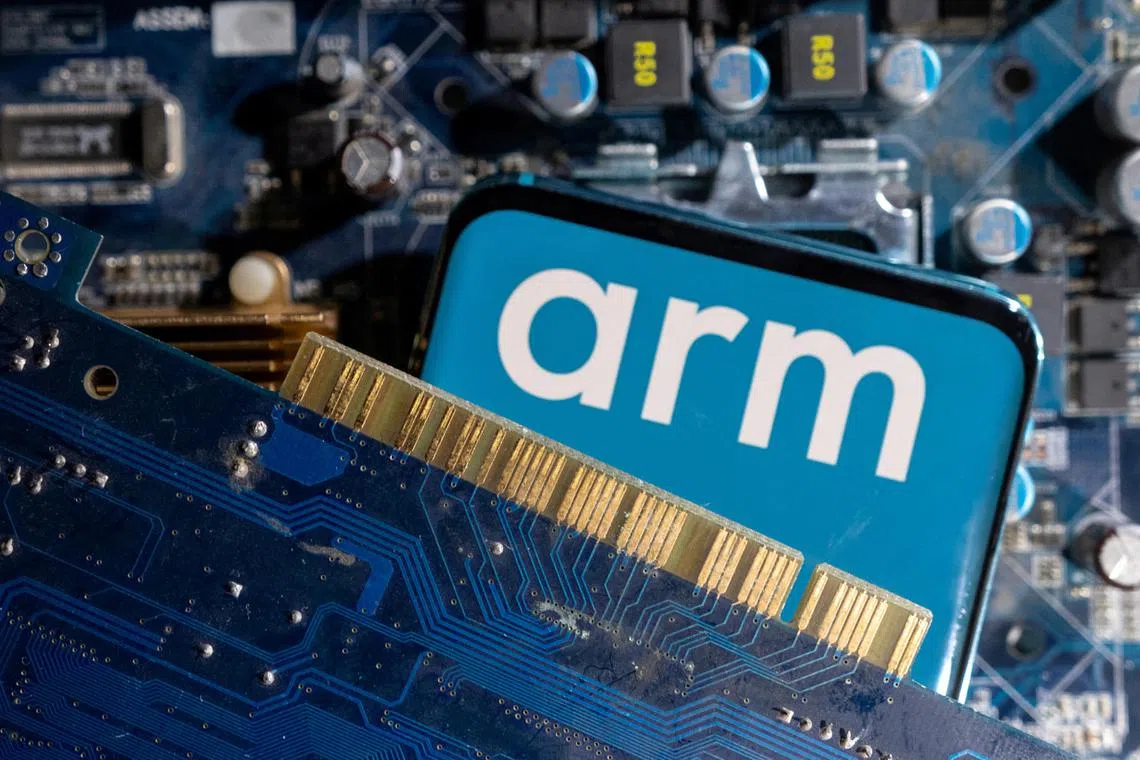SoftBank’s Arm to play key role in Malaysia’s chip ambitions
Sign up now: Get ST's newsletters delivered to your inbox

Malaysia will pay Arm Holdings US$250 million over 10 years to acquire the firm's chip designs and technology.
PHOTO: REUTERS
Follow topic:
Kuala Lumpur - Arm Holdings has agreed to provide chip designs and technology to Malaysia over the next decade, aimed at catapulting the South-east Asian country beyond chip assembly and into more valuable semiconductor production.
Malaysia, which packages roughly a tenth of the world’s semiconductors, has inked a pact to pay the SoftBank Group-owned British company US$250 million (S$334 million) over a period of 10 years for a slew of semiconductor-related licences and knowhow. The government plans to use that to aid local companies design their own chips and target semiconductor exports of RM1.2 trillion (S$365 billion) by 2030.
“We have always wanted to move from the back end – which is on testing and assembly – to the front end,” Malaysian Economy Minister Rafizi Ramli said in an interview with Bloomberg Television on March 5. “The government has taken a radical approach” to work with Arm “with the perspective of building the whole ecosystem”.
With the help of the deal, Malaysia is aiming to create as many as 10 chip companies with total annual revenue of US$20 billion, the minister said. The pact could help add 1 percentage point to the country’s gross domestic product.
Malaysia is already a key hub for chip testing and packaging, but the country has yet to make a meaningful foray into chip design. The country now hosts a number of chip-packaging facilities for Intel, GlobalFoundries and Infineon Technologies. Local chip gear makers are also muscling their way into the global equipment supply chain, attracting the likes of Applied Materials to build factories in the country.
Malaysia in 2024 pledged at least RM25 billion to support its semiconductor industry, while Mr Rafizi had expressed hope that Malaysia would begin producing its own chips in the next five to 10 years, on March 5 he accelerated that timeline to the next five to seven years.
He said the new goal has been made faster by the Arm deal, as developing its homegrown chip technology “organically” would have taken too long.
A vibrant local tech ecosystem led by its own chipmakers would raise Malaysia’s profile in a world of shifting global supply chains, and also drive development of cutting-edge manufacturing processes at home. Given geopolitical uncertainties, supporting local chipmaking has become a top priority in a country where roughly two-fifths of exports are made up of electric and electronic products.
Malaysia started off the year optimistic about its growth prospects, with expectations that the economy could again quicken above 5 per cent on resilient spending and investment. But officials are growing increasingly concerned over the impact of US plans to roll out wide-ranging tariffs that could hurt the trade-reliant nation.
President Donald Trump said in February he would likely impose tariffs on automobile, semiconductor and pharmaceutical imports of around 25 per cent, with an announcement coming as soon as April 2. The US is Malaysia’s third-largest market for semiconductor exports. His imposition of tariffs against Canada and Mexico on Tuesday wiped out all of the S&P 500 Index’s gains since Election Day.
Malaysia joins a growing number of countries that are trying to build domestic production of a component critical to future technologies and national security. Covid-era chip shortages and US-China tensions over trade and Taiwan, home of the most sophisticated production facilities, is prompting nations from Japan to China to try and shore up their local chipmaking capabilities.
Even the US is now trying to revive semiconductor manufacturing at home. But establishing a production base entails not just incentives and capital, but also attracting the necessary talent and the hundreds of smaller suppliers that form a viable chip ecosystem.
The Malaysian government has already began tempering expectations amid the looming threat. Investment, Trade and Industry Minister Zafrul Aziz expects approved investments to increase just 5 per cent in 2025 after jumping 14.9 per cent in 2024. His ministry also targets trade to grow 5 per cent after improving 9 per cent in the previous year.
Malaysia’s central bank is expected to maintain its benchmark interest rate on March 5, as both the economy and inflation remain manageable, for now. Bank Negara Malaysia last adjusted borrowing costs rates with a quarter basis point hike in May 2023. BLOOMBERG

